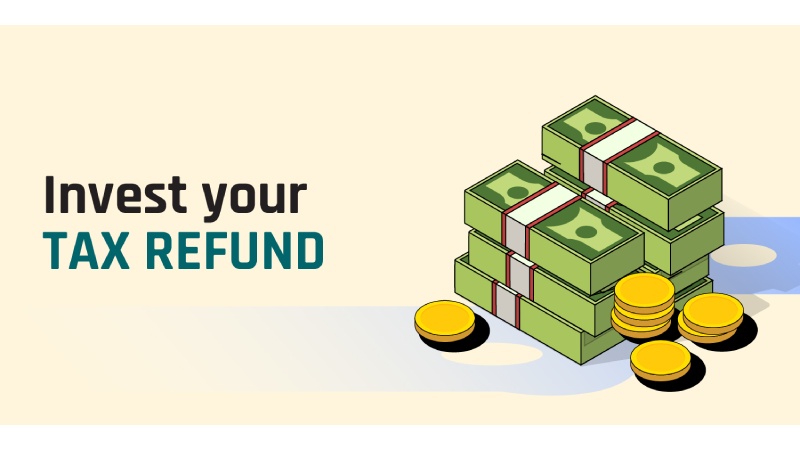News
Investing Your Tax Return: A Guide

Tax Day is coming up soon, and most people are probably rushing to get their paperwork filed. If you’re among the many who will be receiving a refund this year, you might be considering what to do with your tax return.
The Internal Revenue Service (IRS) released data in March that shows the average refund for 2024 is almost $3,200, a slight increase over 2023 figures.
That’s a substantial sum of change, and since that number is only an average, some Americans may receive checks in the next few weeks for amounts greater than that.
Tax refunds provide a much-needed cash infusion for many households, helping them pay for essential expenses. Some may view it as a one-time windfall that they can quickly use for summer vacations, or for those who are riskier, they may use it to invest in equities or cryptocurrency, or other volatile assets.
However, you might want to think about structurally investing your tax return if you’re planning for the long term. We look at how to invest your tax return in this manner here.
Investing your tax return: Put funds into a rainy-day account
Roughly half of Americans, according to studies, have emergency savings of $500 or less. Protecting yourself should be your first investment if this sounds familiar.
Every family is different, and for some, even a few thousand dollars won’t go a long way toward meeting their needs. The Census Bureau reports that the median household income in the United States is slightly less than $75,000. This indicates that roughly $6,000 would be needed for a family living paycheck to paycheck to cover their monthly expenses.
If you do not currently have a safety net in place, you should build one. In addition to offering comfort, this low-risk savings investment can quickly pay for itself when you take into account other factors like a low credit score and the high cost of overdraft fees.
Invest your tax return to pay off debt with a high interest rate
High-interest debt is another structural financial issue that many Americans face; WalletHub reports that the average credit card interest rate is currently approximately 22%.
By just paying off debt and lowering your monthly payments, you’ll get more than twice the value for your money, as research indicates that the stock market typically returns 10% annually.
If you’re not convinced, do the math: if you can only afford to pay $50 a month toward your balance and you have a 22% interest rate on a $2,000 purchase, you will ultimately have to pay more than $4,000 in full for that item.
By paying down the principal value as soon as possible, you can avoid paying twice the original purchase price and instead save a significant amount of interest. Reducing your debt as much as you can is still a smart investment, even if your total balance is greater than your return.
Invest your tax return by creating a Roth IRA
Putting your tax return money into a Roth IRA might make more sense if you’re a patient person. After paying taxes, you can invest money on these platforms and take it out free and clear when you turn 59 ½.
Although it may seem like a long time, you’ll need the money in retirement, and any gains made in the interim could eventually result in a sizable tax return in 2024 when it comes time to cash out.
See a financial or tax advisor for advice on how to invest your tax return
About interest, let’s face it: Since the IRS does not pay you any interest, receiving a sizable tax refund may not always be a good thing. In essence, you’re lending Uncle Sam free money all year long.
If your return is exceptionally high, it might be wise to use the money to hire an expert who can help you maximize your future tax status and position yourself for success.
The majority of tax advisors are content to operate on a fee-only basis, wherein they bill you either an hourly or fixed fee. Even if you choose not to pay for annual tax preparation services, they can usually offer you advice on how to maximize your future deductions and withholding to put more money in your pocket with each paycheck.
In the same manner, fee-only financial advisors take one-time payments in return for successful advice. Many are knowledgeable about tax efficiency and can assist in determining your long-term needs for general financial planning.
Invest your tax return by buying an index fund
If you’re fortunate enough to have debt-free savings and a solid retirement plan, this is great news. This implies that you have the freedom to invest your tax return and use index funds.
These are very inexpensive pooled investment products, such as the well-known iShares Core S&P 500 ETF (IVV), which manages almost $450 billion in assets and contains the 500 biggest U.S. stocks, which include Apple (AAPL) and Microsoft (MSFT). Investors in the exchange-traded fund pay a meager 0.03% in annual expenses or 90 cents on a $3,000 tax return!
You can buy these products in a taxable brokerage account if you want to grow the money fast. But, as you might have predicted, you’ll eventually have to pay taxes on the earnings.
-

 Sports4 weeks ago
Sports4 weeks agoAl Ahly vs Inter Miami, 2025 FIFA Club World Cup – Preview, Prediction, Predicted Lineups and How to Watch
-
Health3 weeks ago
Back to Roots: Ayurveda Offers Natural Cure for Common Hair Woes
-

 Tech3 weeks ago
Tech3 weeks agoFrom Soil to Silicon: The Rise of Agriculture AI and Drone Innovations in 2025
-

 Startup4 weeks ago
Startup4 weeks agoHow Instagram Is Driving Global Social Media Marketing Trends
-

 Science5 days ago
Science5 days agoJuly Full Moon 2025: Everything You Should Need to Know, When and Where to See Buck Moon
-

 Sports3 weeks ago
Sports3 weeks agoFIBA 3×3 World Cup 2025: Full Schedule, Preview, and How to Watch
-

 Gadget3 weeks ago
Gadget3 weeks agoThings to Know about Samsung Galaxy S26: What’s New and What’s Next
-

 Sports4 weeks ago
Sports4 weeks agoWorld Judo Championships 2025: Full Schedule, Date, Time, Key Athletes and How to Watch























